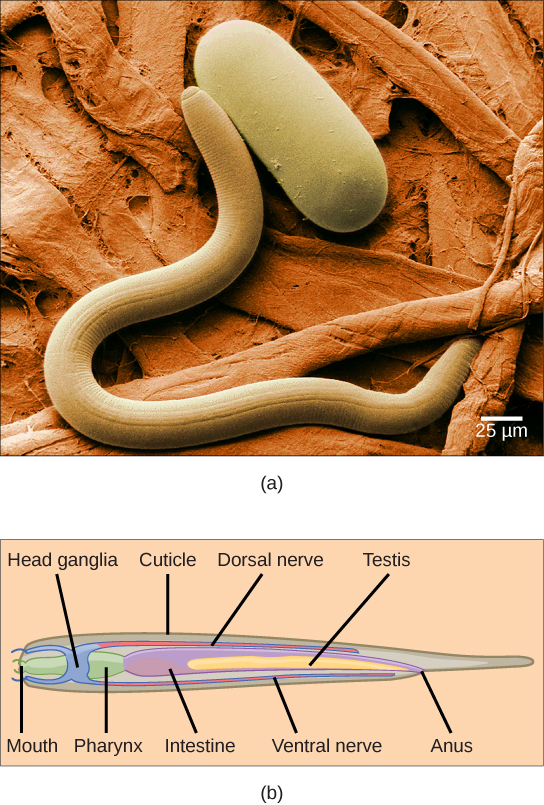| << Chapter < Page | Chapter >> Page > |
The nematodes and the arthropods belong to a clade with a common ancestor, called Ecdysozoa. The name comes from the word ecdysis , which refers to the periodic shedding, or molting, of the exoskeleton. The ecdysozoan phyla have a hard cuticle covering their bodies that must be periodically shed and replaced for them to increase in size. The cuticle provides a tough, but flexible exoskeleton that protects these animals from water loss, predators and other aspects of the external environment. After molting, they secrete a new cuticle that will last until their next growth phase.The presence of an exoskeleton suggests, surprisingly, that phylum Nematoda (the roundworms) is more closely related to the Phylum Arthropoda (the arthropods) than to the other worm phyla.
The phylum Nematoda , or roundworms, includes more than 28,000 species with an estimated 16,000 parasitic species. The name Nematoda is derived from the Greek word “nemos,” which means “thread.” Nematodes are present in all habitats and are extremely common, although they are usually not visible ( [link] ). Nematodes, like most other animal phyla, have three tissue layers, are also bilaterally symmetrical, and consist of both free-living and parasitic forms. It has been said that were all the non-nematode matter of the biosphere removed, there would remain a shadow of the former world in the form of nematodes. Stoll, N. R., “This wormy world. 1947,” Journal of Parasitology 85(3) (1999): 392-396.
Most nematodes look similar to each other: slender tubes, tapered at each end ( [link] ). Nematodes are pseudocoelomates and have a complete digestive system with a distinct mouth and anus.
The overall morphology of these worms is cylindrical, as seen in [link] . The head is radially symmetrical. A mouth opening is present at the anterior end with three or six lips as well as teeth in some species in the form of cuticle extensions. Some nematodes may present other external modifications like rings, head shields, or warts. Rings, however, do not reflect true internal body segmentation. The mouth leads to a muscular pharynx and intestine, which leads to a rectum and anal opening at the posterior end. The muscles of nematodes differ from those of most animals: They have a longitudinal layer only, which accounts for the whip-like motion of their movement.

The nematode body is encased in a cuticle, a flexible but tough exoskeleton, or external skeleton, which offers protection and support. The cuticle contains a carbohydrate-protein polymer called chitin . The cuticle also lines the pharynx and rectum. Although the exoskeleton provides protection, it restricts growth, and therefore must be continually shed and replaced as the animal increases in size.

Notification Switch
Would you like to follow the 'Bi 101 for lbcc ilearn campus' conversation and receive update notifications?